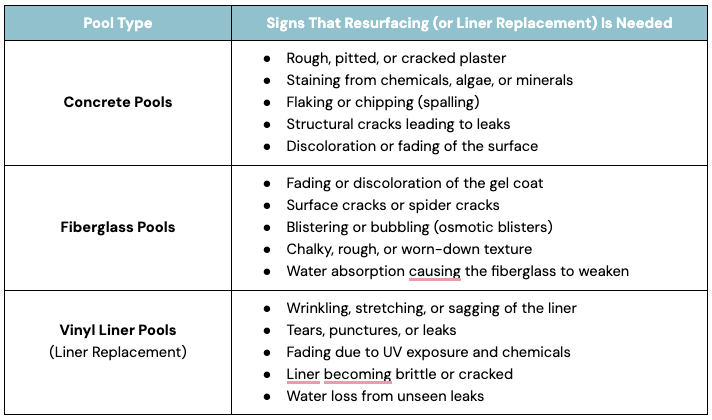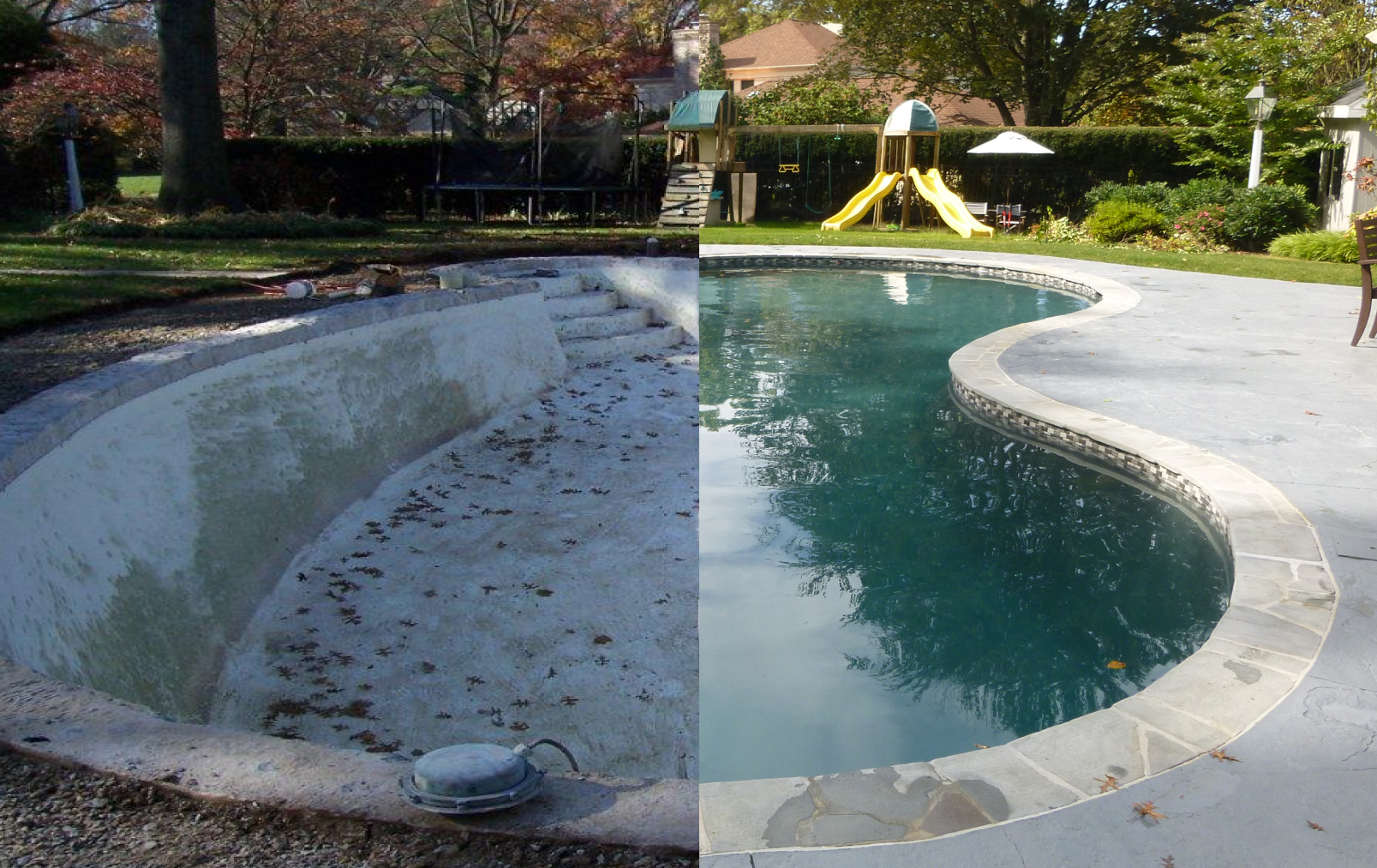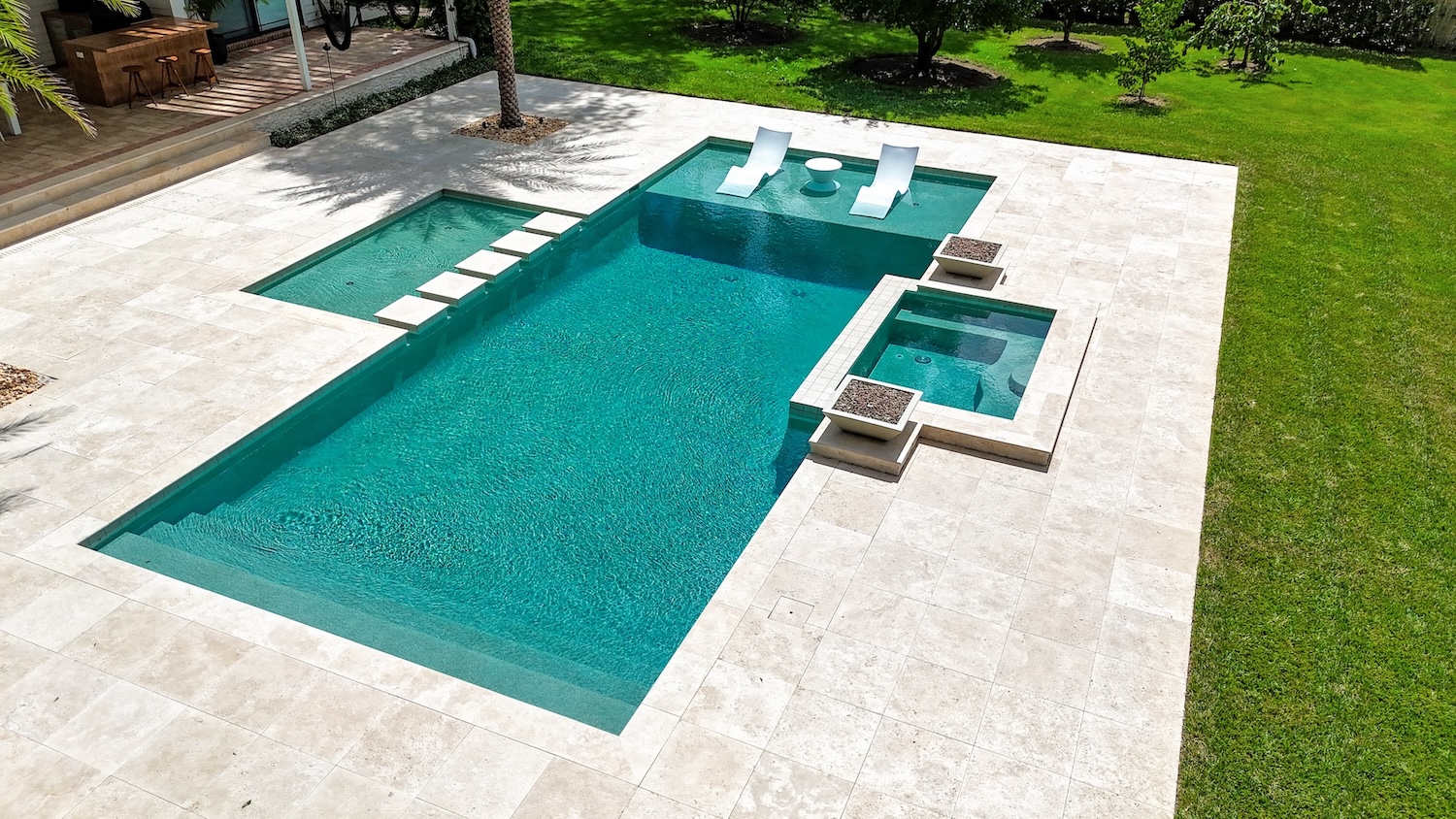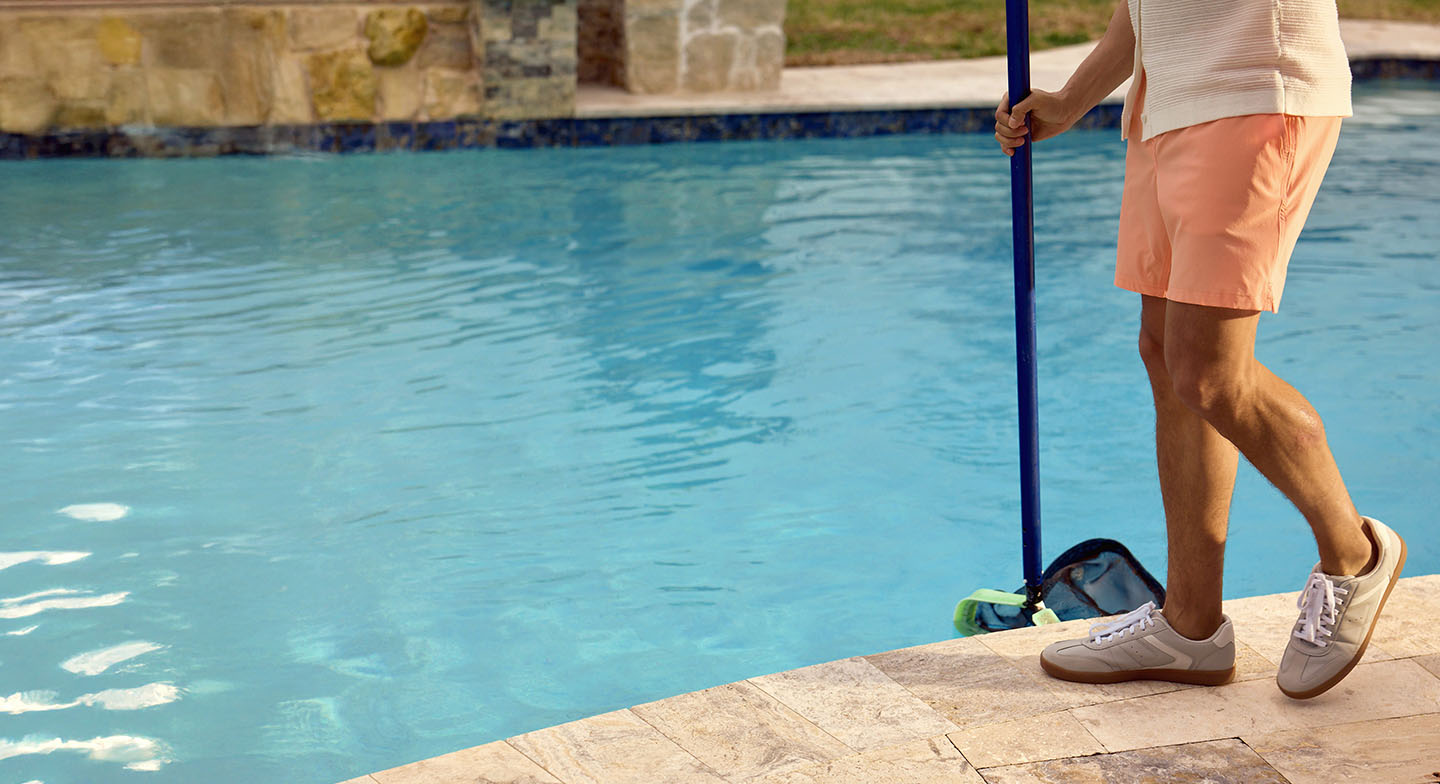A swim should be refreshing—not rough and uncomfortable. If your pool’s surface feels gritty, scratches your feet, or flakes away, it’s a sign the finish is breaking down. Stains, cracks, and fading can make even the cleanest water look uninviting.
Years of chemicals, sun, and water wear down pool surfaces, leading to leaks and structural damage if left untreated. Resurfacing restores a smooth, durable finish, keeping your pool safe, comfortable, and visually appealing.
If your pool feels more worn than welcoming, it’s time to consider resurfacing. Here’s what you need to know.
What is pool resurfacing?
Pool resurfacing, also commonly called pool refinishing, is the process of removing a pool’s existing surface and applying a fresh, durable finish. During this process, a professional will carefully remove the existing pool surface and then add a new layer of high-quality resurfacing material or pool finish. Then, a new sealant is applied to protect the surface and extend its lifespan.
Pool resurfacing is the type of routine maintenance that not only enhances the aesthetic appeal of your swimming pool but also ensures a safer, more enjoyable environment for swimming and relaxation. If you’ve ever been in a pool where your feet get cut up or worn out after touching the bottom and sides of a pool, you’ve been a pool that needs to be resurfaced.
Pro tip: Vinyl pools do not require traditional resurfacing. Instead, they require liner replacement as part of their maintenance cycle.
What signs indicate a pool needs resurfacing?
While each pool is unique, there are common signs that your pool might be in need of resurfacing or other maintenance. Addressing these issues early can prevent more severe damage down the line.
Consider these signs as cues to consult with a professional about pool resurfacing:
- Staining and discoloration: While some stains can be removed with cleaning, deep or persistent discoloration —including rust stains— may indicate a compromised pool finish.
- Flaking or peeling: Noticeable flaking or peeling, whether it’s paint or another surface material, is a sign that the pool’s protective layer is deteriorating.
- Cracks: Cracks in the pool surface or around the pool deck can affect both the aesthetic appeal and structural integrity of your pool.
- Loose or exposed aggregate: If you observe loose or exposed stones, it may suggest that the aggregate in your pool finish is breaking down.
- Worn fiberglass fibers: In fiberglass pools, visible wear of the fibers can indicate that the surface is degrading, necessitating specialized fiberglass pool resurfacing.
We’ve broken this down further by pool type in the following chart:

Even if these signs seem minor, they are important to note. Addressing them promptly by hiring a professional can help preserve your pool’s overall condition and extend its lifespan.
How often should I resurface my pool?
Different types of pools require varying maintenance schedules based on the materials used in their initial construction as well as their environment, upkeep, and frequency of use. An indoor pool that’s rarely used will need to be refinished less frequently than a pool that is exposed to harsh weather and used daily. With that said, here are some general guidelines you can follow:

To be on the safe side, we recommend budgeting for expert pool resurfacing every 10 years, give or take a few years depending on your pool’s environment. Beyond that, you risk wear and tear issues like cracks, fading, or a rough surface which can jeopardize your pool’s integrity and safety.
Again, it’s worth emphasizing that these timelines depend heavily on your pool type. Consult with a trusted professional who understands your specific pool type and environment to ensure you’re resurfacing at the right intervals.
What external factors might make me need to resurface my pool more frequently?
While all pools require resurfacing eventually, certain external factors accelerate wear and deterioration. These environmental and maintenance-related issues can affect the longevity of your pool’s surface and make resurfacing necessary sooner than expected.
- Chemical interactions: Over time, imbalanced pH, alkalinity, and calcium hardness slowly break down pool surfaces, leading to roughness, etching, and structural weakening. High chlorine levels further accelerate deterioration by degrading plaster, gel coats, and vinyl liners, causing them to fade, crack, or become brittle.
- UV exposure and weather conditions: Prolonged sunlight fades finishes and weakens materials, while freezing temperatures cause concrete to expand and crack.
- Water erosion and wear: Constant water movement wears down surfaces, and leaks can lead to structural damage requiring resurfacing.
- Physical damage and age: Regular use, pool equipment malfunctions, and aging materials contribute to surface degradation over time.
- Mineral and metal staining: High iron, copper, and calcium levels in water cause stains and buildup, making surfaces rough and unsightly.
- Improper maintenance and cleaning: Using abrasive brushes or harsh chemicals can damage surfaces, while neglecting routine upkeep accelerates staining and algae growth.
While some of these factors, like weather and aging, may be unavoidable, proper maintenance and water chemistry management can help slow surface deterioration and extend the time between resurfacing projects.
When is the best time to resurface a pool?
The best time to resurface your pool is typically in the fall when cooler temperatures, milder weather, and less frequent rain create ideal conditions for proper curing and adhesion. Extreme heat can cause materials to dry too quickly and crack, while excessive rain can dilute coatings or delay the process. Since pools are used less during this season, the downtime is less disruptive.
Of course, this is a general rule. It’s best to consult a contractor for optimal timing. For example, a local pool expert n hurricane-prone areas like Florida will have a clearer idea of when someone living there should have their pool resurfaced.
Pro tip: Keep in mind that if you’re planning a larger backyard remodel in the near future, coordinating resurfacing with that project can help reduce costs and maximize efficiency.
How long does it take to resurface a pool?
Resurfacing a pool is generally a streamlined process, typically taking between 5 to 14 days to complete. Several factors can influence the timeline, including your pool’s size, shape, and the type of current surface material. Unexpected weather conditions can also sometimes extend your project timeline. A skilled team of professionals like those at Anthony & Sylvan will work efficiently to get the job done.
Finish options for resurfacing a pool
When resurfacing your pool, you may be able to choose from several finish options—such as pool plaster, quartz, aggregate, or pebble finishes—to best match your home’s style and environmental needs. You can use the following chart as general guide, but we provide more detail about each type below (excluding vinyl liner replacement).

Concrete pool resurfacing methods
Plaster
Plaster is a traditional pool finish made by mixing cement, water, and either marble sand or limestone. It provides a smooth and durable surface.
- Durability: With proper maintenance, plaster surfaces can last between 10 to 15 years.
- Considerations: Plaster is porous and can be susceptible to staining and algae growth if not properly maintained.
Aggregate finishes (quartz and pebble):
Aggregate finishes incorporate materials like quartz, pebbles, or glass beads into a cement base, resulting in a textured and aesthetically pleasing surface. Quartz combines crushed quartz with plaster, offering a smooth and durable finish that is more stain-resistant than standard plaster. Pebble finishes feature small, smooth pebbles embedded in the surface, creating a natural look and a non-slip texture.
- Durability: These finishes are known for their longevity, often lasting 15 to 20 years.
- Considerations: Aggregate surfaces are more resistant to chemicals and staining compared to traditional plaster.
Tile
Tile finishes use materials such as porcelain, glass, or stone to create a luxurious and customizable pool surface. Tiles can be glazed, textured, or hand-painted, allowing for intricate designs.
- Durability: High-quality tile surfaces can last over 25 years with proper maintenance.
- Considerations: Tile is typically more expensive than other finishes and requires skilled installation.
Fiberglass Pool Resurfacing Methods
Gel Coat
Fiberglass pools are finished with a gel coat that provides a smooth, non-porous surface. Over time, this coating may fade or develop minor cracks, necessitating resurfacing. Applying a new layer of gel coat restores the pool’s appearance and integrity.
- Durability: A properly applied gel coat can last between 10 to 20 years.
- Considerations: The gel coat is highly resistant to algae growth and requires less maintenance than porous surfaces.
Epoxy Paint
Epoxy paint is a durable coating option for resurfacing fiberglass pools, forming a strong bond that is resistant to stains and chemicals.
- Durability: Epoxy paint can last approximately 7 to 10 years before needing reapplication.
- Considerations: Proper surface preparation is crucial to ensure adhesion and longevity.
Acrylic Paint:
Acrylic paint is a water-based option for pool resurfacing, offering a smooth finish and a variety of color choices.
- Durability: This type of paint typically lasts 2 to 3 years before requiring a new application.
- Considerations: While more affordable, acrylic paint is less durable than epoxy and may require more frequent maintenance.
The pool resurfacing process: 7-step walkthrough
As we’ve detailed, each resurfacing project is unique. The following is a general process, but you’ll want to speak to your pool maintenance professional for the specific process for your pool.
1. Draining the water
Your pool professional will start by draining the pool, ensuring all local regulations are followed and any necessary permits are secured.
2. Preparing the surface
Once the pool is empty, the crew will clear out leaves, dirt, and any debris. They’ll scrub away minor stains and check for cracks or leaks. To create a smooth, clean base for the new surface, the old finish is sandblasted away.
3. Applying the new surface
With the pool prepped, your pool professional will install the new surface based on your chosen finish. Whether it’s tile, aggregate, fiberglass, or a multi-coat paint system, they’ll ensure a precise application that restores both beauty and durability.
4. Sealing the plumbing
All plumbing connections will be inspected and sealed to prevent leaks and keep water circulation running smoothly.
5. Cleanup
Once the new surface has dried and cured, your pool professional will handle a thorough cleanup, removing any remaining dust and debris to prepare the area for refilling.
6. Refilling the pool
Water will be carefully added back to the pool, with close attention to maintaining proper levels and preventing overflow.
7. Balancing the water
Finally, your pool professional will treat and balance the water to ensure it’s safe, clean, and ready for swimming.
Get a pool resurfacing quote from Anthony & Sylvan Pools
Resurfacing a pool depends on your pool’s size, needs, and even climate, making professional expertise essential. If you’re ready to give your pool a fresh new look, trust the experts at Anthony & Sylvan Pools, who have dedicated decades to perfecting pool care and renovations. With unparalleled experience and a commitment to quality, our team ensures your pool is handled with the utmost care.
For a personalized quote and more information on our resurfacing services, contact an Anthony & Sylvan location near you today.




